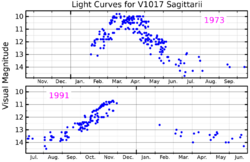Astronomy:V1017 Sagittarii
From HandWiki
Short description: Star in the constellation Sagittarius
 Visual band light curves for the 1973 and 1991 eruptions of V1017 Sagittarii, adapted from Salazar et al. (2017)[1] | |
| Observation data Equinox J2000.0]] (ICRS) | |
|---|---|
| Constellation | Sagittarius |
| Right ascension | 18h 32m 04.4738s[2] |
| Declination | −29° 23′ 12.5935″[2] |
| Apparent magnitude (V) | 4.5±2 Max. 13.5 Min.[3] |
| Characteristics | |
| Spectral type | G5IIIp / white dwarf |
| Variable type | eclipsing recurrent nova (NR+E) |
| Astrometry | |
| Radial velocity (Rv) | 15 km/s |
| Proper motion (μ) | RA: 5.241±0.086[2] mas/yr Dec.: −10.392±0.066[2] mas/yr |
| Parallax (π) | 0.7892 ± 0.0437[2] mas |
| Distance | 1269+84 −60[3] pc |
| Other designations | |
| Database references | |
| SIMBAD | data |
V1017 Sagittarii is a cataclysmic variable star system in the constellation Sagittarius. It first erupted in 1919, reaching magnitude 7. Its other eruptions in 1901, 1973 and 1991 only reached magnitude 10, leading it to be reclassified from a recurrent nova to a dwarf nova.[5]
After the eruption of 1919, the orbital period of the binary system has decreased by 0.0273±0.0061%, to the 5.786290±0.000032 days.[1] Physical models cannot explain the orbital change of such sign and magnitude as in 2019.[6]
References
- ↑ 1.0 1.1 Salazar, Irene V.; Lebleu, Amy; Schaefer, Bradley E.; Landolt, Arlo U.; Dvorak, Shawn (2017). "Accurate pre- and post-eruption orbital periods for the dwarf/Classical nova V1017 SGR". Monthly Notices of the Royal Astronomical Society 469 (4): 4116–4132. doi:10.1093/mnras/stx1161.
- ↑ 2.0 2.1 2.2 2.3 2.4 Brown, A. G. A. (August 2018). "Gaia Data Release 2: Summary of the contents and survey properties". Astronomy & Astrophysics 616: A1. doi:10.1051/0004-6361/201833051. Bibcode: 2018A&A...616A...1G. Gaia DR2 record for this source at VizieR.
- ↑ 3.0 3.1 Schaefer, Bradley E. (2018). "The distances to Novae as seen by Gaia". Monthly Notices of the Royal Astronomical Society 481 (3): 3033–3051. doi:10.1093/mnras/sty2388. Bibcode: 2018MNRAS.481.3033S.
- ↑ "V1017 Sagittarii". SIMBAD. Centre de données astronomiques de Strasbourg. http://simbad.u-strasbg.fr/simbad/sim-basic?Ident=V1017+Sagittarii.
- ↑ Schaefer, Bradley E. (2010). "Comprehensive Photometric Histories of All Known Galactic Recurrent Novae". The Astrophysical Journal Supplement 187 (2): 275–373. doi:10.1088/0067-0049/187/2/275. Bibcode: 2010ApJS..187..275S.
- ↑ Schaefer, Bradley E. (2020). "Sudden and steady orbital period changes across six classical Nova Eruptions: The end of hibernation and two serious challenges for the magnetic braking model of cataclysmic variable evolution". Monthly Notices of the Royal Astronomical Society 492 (3): 3343–3358. doi:10.1093/mnras/stz3424.
 |

